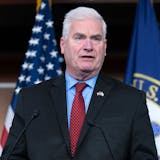Opinion editor's note: Star Tribune Opinion publishes a mix of national and local commentaries online and in print each day. To contribute, click here.
•••
As of July, inflation in the Twin Cities over the past year was 1%. That was one of the lowest rates for any metropolitan area in the country and led to a bit of a victory lap when the national media featured our region. Filling out this story, a number of observers tied this low inflation rate to a local housing market producing housing at a high rate, which naturally gives us a sense of pride. Is that sense of accomplishment deserved? Yes and no.
We agree that housing production should be the focus today and in the future, but it's way too soon to declare victory.
Before making our case, we should be clear about what inflation is and is not. Inflation is the rate of change in prices for the "basket of goods and services" — that is, for the things we buy. It is not a measure of how expensive the items in the basket are. For instance, when the cost of a new car (whether it is a base model or fully loaded) rises over time, car-price inflation is positive. If the cost stops rising, car-price inflation would be zero, even though the car is more expensive than it used to be.
In terms of the "yes" part of the argument, two clear facts justify seeing housing as an explanation for our low inflation.
First, housing production is, in fact, up. The Itasca Project — an employer-led civic alliance focused on prosperity for all — has set housing production goals for our region. The group argues that the Twin Cities region should produce at least 18,000 housing units annually in order to keep pace with household growth, erase the deficit of production left by the Great Recession and provide enough cushion in housing supply to slow the rise in housing prices. The good news is that production has exceeded this goal each year since 2019. As the Regional Housing Affordability Dashboard that we developed with the Itasca Project shows, production reached a record of 22,570 units in 2021.
Second, housing prices are actually rising here at a lower rate than in the rest of the country. Housing (technically called "shelter") is by far the biggest single item households purchase and makes up about one-third of the basket. While inflation is 1% in the Twin Cities, it was 3.2% in the nation as a whole. (There are several measures of inflation; we are talking about inflation over the last 12 months measured by the "headline" Consumer Price Index.) About half of the difference between inflation in the Twin Cities and inflation in the nation is accounted for by the fact that housing prices are growing slower here than in the nation as a whole. Housing prices are rising about 4% in the Twin Cities and almost 8% in the country overall.

